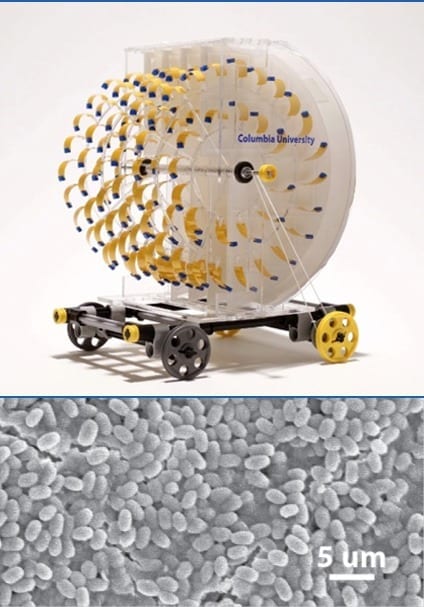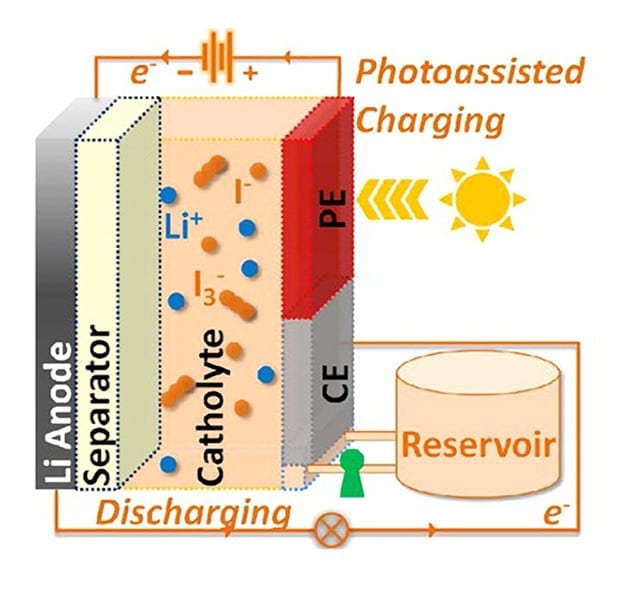
Bacterial spore-polymer composites harness energy from evaporation to power locomotion and generate electricity
The Science
Could water evaporating provide power? Biological systems are known to convert energy generated from the evaporation of water confined within nanoscale compartments into muscle-like mechanical work in response to changes in environmental humidity. Recently, scientists designed shape-changing engineered composites of bacterial spores and a polymer that used an evaporation-driven process to power locomotion and generate electricity.
The Impact
By harvesting the energy from water evaporation in the environment researchers demonstrated self-sustained power generation from engines placed at air-water interfaces. These evaporation-driven engines could power robotic systems, sensor, devices, and machinery.
Summary
Evaporation is a powerful natural force able to extract and deliver water over great distances, from oceans to mountaintops. On a smaller scale, biological systems harness the energy of evaporation, such as when wheat releases pollen and pine cones release seeds. These biological systems convert energy generated from the evaporation of water confined within nanoscale compartments into mechanical work in response to changes in environmental humidity. Extending this energy conversion ability to human-made systems has proven to be difficult. One reason is the decreased evaporation rates in larger engineered assemblies (compared to confined spaces) coupled with the slow rate of change in humidity.
As a result, scaled-up energy conversion systems based on water evaporation and adsorption cycles have been a neglected area of research. Scientists at Columbia University have effectively harvested energy from evaporation in the environment to drive engines that start and run autonomously when placed near a water surface. Arrays of artificial “muscles” composed of bacterial spores on a polymer strip enhanced the water evaporation rates when scaled-up. Researchers optimized the thickness of the spore layer for rapid water transport into and out of the nanopores. The energy of evaporation was harnessed to power the muscle.
A small portion of the power operated a feedback mechanism to address the slow and variable rate of change in environmental humidity, enabling rapid cycling between spore swelling to stretch the muscle and shrinking to contract the muscle. Upon stretching at a desired humidity, the self-regulating feedback mechanism allows the humidity to decrease. Precise control of this process enabled self-sustained power generation from piston-driven and rotary engines when placed at air-water interfaces—powering a light source and moving a miniature car forward. These results could enable evaporation-driven engines to power robotic systems and sensors.
Read more: Evaporation-powered Motor and Light
The Latest on: Evaporation-powered motor
[google_news title=”” keyword=”Evaporation-powered motor” num_posts=”10″ blurb_length=”0″ show_thumb=”left”]
via Google News
The Latest on: Evaporation-powered motor
- What to Do if Your Air Conditioner Is Not Cooling Your Spaceon April 26, 2024 at 11:04 am
Refrigerant, the liquid used in an AC system, undergoes a continuous cycle of evaporation and condensation ... protect the electrical system when the motor fails. If the circuit is tripped and ...
- Honda Civic 9th Generation 2012-2015 (FB/FG) Review: All Trims, Facelift Includedon April 26, 2024 at 7:36 am
From 2014, Honda's LaneWatch blind-spot monitoring system is standard on EX, EX-L, and Hybrid models, which is displayed on the infotainment screen. 2015 adds dynamic guidelines to the backup camera ...
- Think you understand evaporation? Think again, says MITon April 25, 2024 at 4:21 am
We all know that water evaporates when the temperature climbs, but researchers have just shown that there's another factor at play. The breakthrough could solve long-standing atmospheric mysteries and ...
- “Drinking Bird” Becomes an Evaporation-Driven Triboelectricity Energy Harvesteron April 22, 2024 at 9:42 am
Researchers combined the drinking bird toy with a triboelectric arrangement to create a high-voltage energy-harvesting scheme.
- EVs get efficiency boost from new heat pump technologyon April 17, 2024 at 10:57 am
While improving electric vehicle range usually focuses on battery pack size, power electronics, curb weight and aerodynamics, a heat pump bolsters EV efficiency, especially in cold weather.
- John Wheeler: Summer weather patterns are weaker, but storms are strongeron April 4, 2024 at 10:01 pm
As the temperature difference between the Arctic and the equator decreases, the power of the jet stream ... their energy from the thermodynamics of evaporation and condensation of water.
- Beak power: how a toy that stumped Einstein is inspiring Chinese scientists to search for cleaner energyon March 15, 2024 at 1:39 am
Simple physics behind vintage 'drinking bird' leads to 'substantial renewable energy opportunity', researchers say Evaporation-driven heat engine could someday power electric gadgets A team of ...
- 11 Things To Know About Toyota's Hydrogen Combustion Engineon January 26, 2024 at 4:00 pm
The droplets of water injected dissipate heat through evaporation ... Ferrari's recent patent for a hydrogen-powered combustion engine is as intriguing as it is surprising, giving a potential ...
- P0456 Code: How To Fix EVAP System Leak Detectedon September 14, 2023 at 5:43 am
The EVAP system is crucial for lowering the ... Before removing it, wait at least 30 minutes with a turned-off engine. Separate it from the power terminal and unscrew the clamps holding to the ...
- Energy From Evaporation Could Power Much of US, Study Findson September 25, 2017 at 5:00 pm
While solar and wind power are limited by day-to-day fluctuations ... A machine developed in his lab, the Evaporation Engine, can control humidity with a shutter that opens and closes, triggering ...
via Bing News









